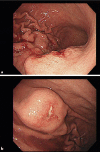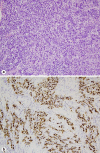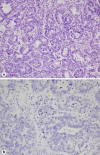Concurrent Gastric Adenocarcinoma of Fundic Gland Type and Carcinoma with Lymphoid Stroma: A Rare Case Report
- PMID: 27462199
- PMCID: PMC4939682
- DOI: 10.1159/000444277
Concurrent Gastric Adenocarcinoma of Fundic Gland Type and Carcinoma with Lymphoid Stroma: A Rare Case Report
Abstract
Both gastric adenocarcinoma of fundic gland type (ADC-FG) and carcinoma with lymphoid stroma (lymphoepithelioma-like carcinoma, LELC) are relatively rare. Epstein-Barr virus (EBV) has been implicated in the pathogenesis of LELC. However, the pathogenesis of ADC-FG, as well as the role of EBV in the carcinogenesis of LELC, remain unclear and under debate. The current study presents a case of concurrent ADC-FG and LELC in the stomach in a 69-year-old man. Total gastrectomy was performed, and two separate masses were identified. Upon histological and immunohistochemical examination, the mass located in the lower body was determined to be LELC and the mass in the upper body was diagnosed as ADC-FG. The lesions were characterized by different mucin phenotypes and EBV in situ results. In the lower-body mass, EBV in situ hybridization expression was diffusely strongly positive, but MUC2, MUC5AC, MUC6, and CD10 were all negative. On the other hand, in the upper-body mass, the results were positive for MUC6 but negative for MUC2, MUC5AC, CD10, and EBV by in situ hybridization. The remaining gastric tissue was unremarkable, and perigastric lymph node metastases were absent. Seven months after the gastrectomy, a postoperative computed tomography scan revealed no recurrence or metastasis.
Keywords: Adenocarcinoma of fundic gland type; Carcinoma with lymphoid stroma; Stomach.
Figures





References
-
- Lauren P. The two histological main types of gastric carcinoma: diffuse and so-called intestinal-type carcinoma. Acta Pathol Microbiol Scand. 1965;64:31–49. - PubMed
-
- Nakamura K, Sugano H, Takagi K. Carcinoma of the stomach in incipient phase: its histogenesis and histological appearances. Gann. 1968;59:251–258. - PubMed
-
- Kabashima A, Yao T, Sugimachi K, Tsuneyoshi M. Gastric or intestinal phenotypic expression in the carcinomas and background mucosa of multiple early gastric carcinomas. Histopathology. 2000;37:513–522. - PubMed
-
- Tsukamoto T, Yokoi T, Maruta S, Kitamura M, Yamamoto T, Ban H, Tatematsu M. Gastric adenocarcinoma with chief cell differentiation. Pathol Int. 2007;57:517–522. - PubMed
-
- Singhi AD, Lazenby AJ, Montgomery EA. Gastric adenocarcinoma with chief cell differentiation: a proposal for reclassification as oxyntic gland polyp/adenoma. Am J Surg Pathol. 2012;36:1030–1035. - PubMed
Publication types
LinkOut - more resources
Full Text Sources
Other Literature Sources
Miscellaneous

